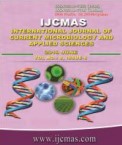


 National Academy of Agricultural Sciences (NAAS)
National Academy of Agricultural Sciences (NAAS)

|
PRINT ISSN : 2319-7692
Online ISSN : 2319-7706 Issues : 12 per year Publisher : Excellent Publishers Email : editorijcmas@gmail.com / submit@ijcmas.com Editor-in-chief: Dr.M.Prakash Index Copernicus ICV 2018: 95.39 NAAS RATING 2020: 5.38 |
The influences of tillage systems on soil carbon (C) stocks have been studied extensively, but the distribution of soil C within aggregate fractions is not well understood. This review study was to determine the influences of various tillage systems on soil aggregation and aggregate-associated C under rice-wheat rotation in North India. The NT and RT treatments significantly increased the proportion of macro-aggregate fractions (>2000 and 250-2000μm) compared with the MP-R and MP+R treatments. Averaged across all depths, mean weight diameters of aggregates (MWD) in NT and RT were 47 and 20% higher than that in MP+R. The difference of total SOC stocks between NT and CT decreased with soil depth, confirming that the SOC benefits of NT are concentrated to the immediate topsoil still subject to direct seeding. The topsoil achieved maximum SOC stocks after about 10 years of NT. In surface soil, the maximum (19.2%) and minimum (8.9%) proportion of total aggregated carbon was retained with >2 mm and 0.1–0.05 mm size fractions, respectively. DSR combined with zero tillage in wheat along with residue retention (T6) had the highest capability to hold the organic carbon in surface (11.57 g kg-1soil with the highest stratification ratio of SOC (1.5). A considerable proportion of the total SOC was found to be captured by the macro-aggregates (>2–0.25 mm) under both surface (67.1%) and sub-surface layers (66.7%) leaving rest amount in micro-aggregates and silt + clay sized particles. However increasing the quantity of C input could enhance soil C sequestration or reduce the rate of soil C loss, depending largely on the local soil and climate conditions. SOC can be best preserved by crop rotations with conservation tillage practices such as no or reduced tillage, and with additions of residues, chemical fertilizers and manure SOC change was significantly influenced by the crop residue retention rate and the edaphic variable of initial SOC content. Soil disturbance by tillage leads to destruction of the protective soil aggregate. This in turn exposes the labile C occluded in these aggregates to microbial breakdown. A higher amount of macro-aggregates along with greater accumulation of particulate organic C indicates the potential of conservation tillage for improving soil carbon over the long-term in rice-wheat rotation in North India.
 |
 |
 |
 |
 |